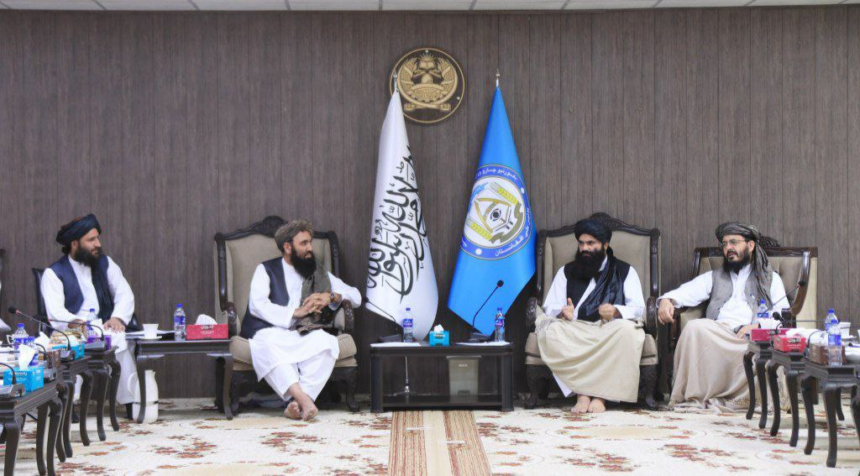RASC News Agency: After more than a month of unexplained absence from public view, Sirajuddin Haqqani, the Taliban’s powerful Minister of Interior and leader of the Haqqani Network, made a highly anticipated return to the Ministry on Sunday, April 20. His reappearance follows 37 days of silence that fueled widespread speculation about growing internal discord within the Taliban’s ranks. The Ministry of Interior released official photographs from a leadership meeting chaired by Haqqani, attended by senior deputies, departmental directors, and high-ranking commanders. According to the ministry, the meeting aimed to review the performance of subordinate agencies and enhance operational coordination among security units.
Haqqani’s last official engagement at the ministry was recorded on January 14, during a meeting with the Saudi chargé d’affaires in Kabul. A week later, images emerged showing him in the United Arab Emirates, where he held talks with Sheikh Zayed bin Nahyan. Following that visit, however, Haqqani vanished from the public sphere a disappearance that drew increasing attention from political observers and Taliban insiders alike.cHis absence coincided with growing speculation regarding deepening rifts within the Taliban’s leadership structure, particularly between the Kandahar-based circle loyal to Supreme Leader Hibatullah Akhundzada and members of the Haqqani network, which operates with a degree of independence and influence in eastern Afghanistan.
Sources close to Taliban leadership told RASC News that Haqqani reportedly voiced concern during a closed-door meeting in Kandahar over the consolidation of authority in the hands of Akhundzada. According to these sources, Haqqani warned that the centralization of power and lack of consultation with key factions risked causing fractures within the group and undermining its already fragile unity. These concerns mirror long-standing tensions within the Taliban’s leadership since their return to power in August 2021. While the Kandahar faction, led by Akhundzada, is known for its ultraconservative stance and resistance to reform, the Haqqani faction has adopted a more pragmatic approach, especially concerning engagement with foreign actors and managing urban governance.
Haqqani’s absence is not an isolated case. Abbas Stanekzai, the Taliban’s Deputy Foreign Minister for Political Affairs, has not appeared in public for nearly three months. According to diplomatic sources, Stanekzai quietly left Afghanistan for the United Arab Emirates after voicing dissent against the regime’s increasingly restrictive policies particularly the continued ban on girls’ education and the rollback of women’s rights. To date, Taliban officials have neither confirmed nor denied Stanekzai’s departure or his potential return, further fueling speculation about a broader internal crisis.
The recent developments underscore the mounting ideological and strategic divisions within the Taliban’s upper echelons, which analysts warn could have significant implications for the group’s long-term cohesion and governance capacity. The Taliban’s failure to present a unified front particularly as international isolation intensifies and domestic discontent grows raises serious questions about the sustainability of their rule. Sirajuddin Haqqani, long regarded as a key power broker within the Taliban, enjoys deep-rooted ties with regional intelligence networks and has played a critical role in security operations, intelligence coordination, and internal policing. His sidelining or disillusionment, even if temporary, could signal deeper instability within the Taliban’s governing apparatus.
In light of these internal rifts, observers suggest that the Taliban leadership may face increasing pressure to either adopt a more inclusive decision-making framework or risk further fragmentation. With Afghanistan facing acute humanitarian crises, economic collapse, and diplomatic isolation, internal disunity within the Taliban could further complicate efforts toward national stabilization and international engagement.






